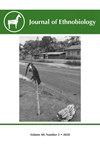萨哈文化中的植物:名称、知识和栖息地
IF 1.3
3区 社会学
Q1 ANTHROPOLOGY
引用次数: 0
摘要
摘要萨哈人(或雅库特人)对植物的知识和利用反映在他们根据栖息地为植物命名的做法上。萨哈人是一个突厥民族,总人口约为50万,主要生活在俄罗斯联邦萨哈共和国(雅库特)的广大领土上,该地区包括北极和亚北极地区。由于植物在萨哈人的生活中占有重要地位,萨哈人的植物词典编码了关于萨哈人如何与环境互动的知识和文化信息。本文对43种植物名称进行了民族语言学分析;选择这些植物是因为它们的名字表明了它们的栖息地。我们使用语言分析、民族语言学田野调查、问卷调查和已发表资源验证的混合方法来了解植物名称的语言结构,它们对使用者的意义,以及这些植物如何在传统萨哈医学中更广泛地使用。我们发现,这些名称提供了如何定位具有实际用途(作为药物和食物)的植物的关键信息。还提供了来自几种未经研究的方言的信息。本文章由计算机程序翻译,如有差异,请以英文原文为准。
Plants in the Sakha Culture: Names, Knowledge, and Habitat
Abstract. Knowledge and use of plants among the Sakha (orYakut) people are reflected in their naming practices for the plants according to habitat. The Sakha are a Turkic people with a total population of approximately 500,000, living primarily in the vast territory of the Republic of Sakha (Yakutia) in the Russian Federation, a region comprising Arctic and Subarctic zones. The Sakha plant lexicon encodes knowledge and cultural information about how the Sakha engage with their environment, as plants occupy an important place in their life. The present article represents an ethnolinguistic analysis of 43 plant names; these plants were chosen as their names indicate their habitats. We used a mixed-methods approach of linguistic analysis, ethnolinguistic fieldwork, questionnaires, and verification with published resources to understand the linguistic structure of the plant names, what they mean for users, and how the plants are used in traditional Sakha medicine, more broadly. We found that the names provide key information as to how to locate plants that have practical uses (as medicine and as food). Information from several unstudied dialects is also provided.
求助全文
通过发布文献求助,成功后即可免费获取论文全文。
去求助
来源期刊

Journal of Ethnobiology
Social Sciences-Anthropology
CiteScore
4.80
自引率
3.40%
发文量
21
审稿时长
>12 weeks
期刊介绍:
JoE’s readership is as wide and diverse as ethnobiology itself, with readers spanning from both the natural and social sciences. Not surprisingly, a glance at the papers published in the Journal reveals the depth and breadth of topics, extending from studies in archaeology and the origins of agriculture, to folk classification systems, to food composition, plants, birds, mammals, fungi and everything in between.
Research areas published in JoE include but are not limited to neo- and paleo-ethnobiology, zooarchaeology, ethnobotany, ethnozoology, ethnopharmacology, ethnoecology, linguistic ethnobiology, human paleoecology, and many other related fields of study within anthropology and biology, such as taxonomy, conservation biology, ethnography, political ecology, and cognitive and cultural anthropology.
JoE does not limit itself to a single perspective, approach or discipline, but seeks to represent the full spectrum and wide diversity of the field of ethnobiology, including cognitive, symbolic, linguistic, ecological, and economic aspects of human interactions with our living world. Articles that significantly advance ethnobiological theory and/or methodology are particularly welcome, as well as studies bridging across disciplines and knowledge systems. JoE does not publish uncontextualized data such as species lists; appropriate submissions must elaborate on the ethnobiological context of findings.
 求助内容:
求助内容: 应助结果提醒方式:
应助结果提醒方式:


